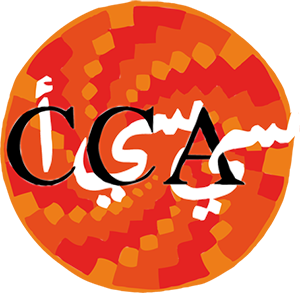The MCC General Meeting recently took place in Alghero, Sardinia, gathering alumni from all past Mosaic Conservation Courses. Eighteen participants from Syria, Jordan, Tunisia and Libya gave presentations on projects carried out in their institutions. In the next weeks we’ll be posting reports on each of the four sessions.
Session 1 saw four presentations from members of the Syrian Directorate General of Antiquities and Museums (DGAM). The first three speakers attended MCC courses in 2011 and 2012, while the last has just completed a course.
Borhan Alzraa gave a detailed description of the cleaning and consolidation work carried out on the mosaics of the Omayyad Mosque in Damascus, which had suffered extensive damage caused by mortar shells. Working “tessera by tessera”, Borhan and his colleagues carried out chemical cleaning of the blackened surface and injected mortar to consolidate cracks and detached tesserae. Read more about their project on the Syrian DGAM website.
His colleague Mohammad Al Kaeed described the thorough documentation process carried out during all stages of intervention, which proved challenging due to the working height (16 m from the ground!). Detailed examination and drawing of the surface offered the context for researching the mosaics’ history and technology, building on the work carried out in the past by scholars such as François Bogard, Phenè Spiers and Michel Ècochard among others.
Maher Jbaee reviewed several case studies of recent conservation work carried out in Syria to highlight how professionals working in the field have benefited from MOSAIKON courses. In particular, he noted the increased care that goes into appropriate documentation, an aspect that was frequently ignored in the past, causing major loss of information.
Moutaz Alshaieb is the first “second generation” MCC trainee, as he was trained in Syria by his senior colleagues, who are past MCC participants themselves. He presented the preliminary stages of work carried out under the supervision of Maher Jbaee on a mosaic from Shahba, the ancient Philippopolis, which had been lifted without any documentation in the ‘70s. This had complicated the re-assemblage process, which is still in progress.
In the subsequent discussion Komait Abdallah, Director of Scientific Laboratories of the Syrian DGAM, commented that the presentations show how the MCC program has given Syrian trainees the confidence and technical means to carry out challenging projects, improving their ability to plan and manage complex treatments.
Aicha Ben Abed, Director of research at Institut National du Patrimoine de Tunisie and MOSAIKON Regional Coordinator thanked the Syrians for their incredible efforts in such difficult times. She asked about the specific needs heritage professionals face at present, and how the international community can help. In the following discussion, the scarce availability of specialized materials, lack of adequately trained staff and of equipped workspaces emerged as key issues for the Syrian DGAM. The need for continued support by international organizations such as UNESCO was also deemed essential.
